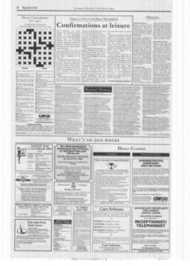Page 5, 16th June 1995
Page 5

Report an error
Noticed an error on this page?If you've noticed an error in this article please click here to report it.
Tags
Share
Related articles
Franciscans In Croatia Warned Against Violence
Bosnian Bishop's Plea
Bosnian Catholics On 'the Verge Of Extinction'
Can This Man Heal The Red Wounds Of Sarajevo?
Retired Anglican Clergyman Paved Way For Pope's Historic...
Cleansing Bosnia of its Catholic influence
As Britain draws deeper into the Bosnian conflict, the fate of the Catholic community in the city of Banja Luka is grim. Paul Hockenos observes the end phase of ethnic cleansing.
BANJA LULU: ALONG the
tree-lined King Peter! __._ Street, a pack of stray dogs sun themselves in a rock-strewn corner lot. The homeless dogs once belonged to Muslim and Croat citizens before they fled this northern Bosnian city, the largest under Bosnian Serb control, An eerie reminder of their owners' fate, the animals rest on the corner where the 400-year-old Ferhad Pasha Mosque stood, before Serbian extremists blew it up two years ago.
The destruction of mosques and Catholic churches is part of the ethnic cleansing campaign that has nearly wiped out the Muslim and Catholic Croat populations in this once multinational region.
The elegant Ferhad Pasha was one of the 16 mosques in Banja Luka before war broke out three years ago. Today, there is not a single mosque standing in all of Serb-held Bosnia.
Before the war, this beautiful Habsburg-influenced city had a population of 140,000, roughly half Serbs and half Muslims and Croats. Only about 10,000 or so Muslims and Croats remain in the city, and every month there are fewer.
Ethnic cleansing continues unabated in northern Bosnia, although in a different manner than during 1992-93, when Muslims and Croats were beaten up, fired from their jobs, or turned out of their homes at gun point and killed.
"Today there is less physical violence," says Vladimir Curko, director of the UN refugee program in northern Bosnia, describing what some observers call the "end phase" of ethnic cleansing.
The pressure put on minorities to leave now takes softer forms, but it is no less effective."
Muslims and Croats, for example, are sent to the frontlines as part of obligatory work crews. "Most civilians would rather leave the country than risk their lives like this, and the authorities know that," says Curko. The UN estimates that from over 500,000 Muslims and Croats in northern Bosnia before the war, today there are less than 70,000 in Serb-held territory.
The city's Civil Migration Office processes the paper work and arranges transportation for evacuation. The mandatory price is 250 German marks per head, in hard currency.
An uneasy calm prevails over Banja Luka after the successful Croatian milit,ary offensive in Western Slavonia two weeks ago, just 50 kilometers north of here. Heavily armed police, part of an extensive and feared force, stand at nearly every intersection.
The region's Catholic Croats have paid dearly for Croatia's victory. A week after the offensive, four more Catholic churches were blown sky high.
Today, those people preparing to leave Ban ja Luka gather at the far end of the outdoor market, where they offer their last possessions for sale.
On old blankets, they display pots and pans, tools, window frames and doorknobs, anything they cannot carry with them. Six gypsy women, squatting in a circle, say they wanted to leave last week, but authorities closed the borders when fight ing broke out in Western Slavonia.
Outwardly, Banja Luka, which never experienced fighting, appears prosperous and upbeat. Even the houses that belonged to Muslims and Croats are mostly intact, unlike the ransacked Muslim villages outside the city.
The houses' new occupants tack small blue-whitered Yugoslav flags on their doors. "This means that a Serb now lives there," explains Ljubica, a French teacher and child of a mixed Muslim-Serb marriage. "It shows they're proud of it."
Along the sparkling waters of the River Vrbas, the greywhite ruins of detonated mosques lie in toppled piles. "We old folks, we're the only Muslims left," says a withered peasant woman tend
ing a small garden plot with a friend.
"My sons, grandsons and now great grandsons are in Sweden, Croatia and Canada. I'm too old to leave. I'll die here one way or another."
Today, there are fewer "problems" than before, she says. The police are more responsive when their houses are shot at, for example. As she speaks, a young blondhaired man rides by in a horse drawn cart. The other woman raises her finger to her lips. "Quiet", she whis pers, "Those young ones from the village, there's nothing they won't do."
The Serbs in Banja Luka show little remorse about the fate of their city.
"Nobody wanted to see this happen." says Maria. 29, a mother of two. But why, she asks, were there 16 mosques and only one Orthodox church?
"It wasn't right to blow them all up," she reflects, "but perhaps sixteen was too many."
Serbs and non-Serbs alike have noticed 'a definite change in mood of late in the city. The nationalist euphoria that gripped Bosnian Serbs when the war broke out has waned.
"Before, any word against Karadzic was considered treason," explains Ljubica. "Today, everybody curses Karadzie and the war. But they only criticise the corruption and the shortages, not his political goals or ethnic cleansing.
"People here want to live in their Greater Serbia in peace and quiet."
Paul Hockenos is the author of Free to Hate: The Rise of the Right in Post Cornmurn:st Eastern Europe (Routledge)
blog comments powered by Disqus











